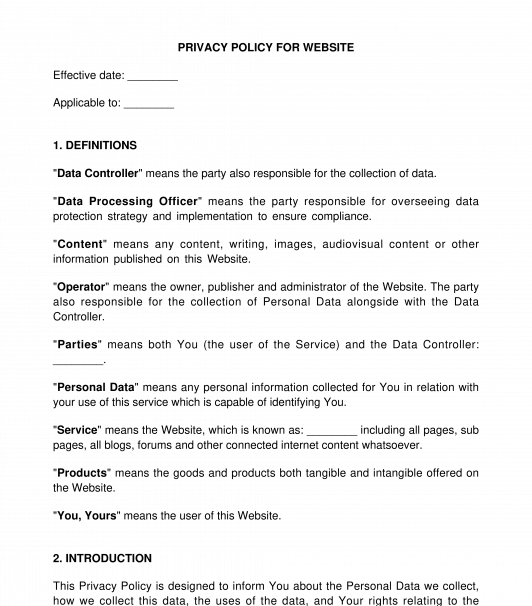 30/09/2025
30/09/2025

Answer a few questions and your document is created automatically.

Your document is ready! You will receive it in Word and PDF formats. You will be able to modify it.

 30/09/2025
30/09/2025
 Word and PDF
Word and PDF
 4 to 6 pages
4 to 6 pages



The Privacy Policy of Website/Mobile Application is a document informing website/application users about the use, management and disclosure of their personal information. Within this Privacy Policy, the operator will be able to choose whether the document should apply to a website or mobile application.
Personal information includes name, email address, bank details, post on social network websites, medical information, computer IP address of users, etc.
This document explains how a user's information is gathered, (whether it is active collection (such as the asking the user to enter its personal details) or passive information (through the use of cookies)) stored and used. Cookies are small text files stored in the browser of the user when the user visits a website. They are used to store the users' preferences so that the web server does not have to repeatedly request the information every time users visit the website or application. They are commonly used to store the users' information (which may be personal or other type of information) such as the users' name, username, address, password, email address, the contents of a shopping cart, etc. This helps the operator provide a personalized user experience to their users.
The users are not required to sign this document. However, they are deemed to have given consent by the continuing to use the website/application, thus creating a binding contract between the users of the website/application and the operator.
How to use this document
In this document, the information to be outlined by the operator of the website/application include, but not limited to the following:
This document must be used by any party that operates a website or mobile application which will be accessible to users.
After filling the form, it should be published on a separate page on the website or application.
Some websites or applications simply make the Privacy Policy available on a separate page, usually accessible via a hyperlink that appears on the same page. In this case, the end user may not review the document before accepting the contract. This is called the browse wrap agreement.
Other websites or application make the users take positive steps to confirm that the user has read the Privacy Policy. For example, the site or application may have a pop up box showing the terms and conditions where the user will be required to scroll all the way through the Privacy Policy before checking the box saying "I understand the terms and conditions of this website and have agreed to be bound by them". This is called a click wrap agreement.
This Privacy Policy will go hand in hand with a Terms and Conditions of Use and Cookie Policy which are also available for sale.
Applicable laws
On May 25, 2018, the European Union (EU) General Data Protection Regulation (GDPR) came into effect to ensure the protection of personal data. It addresses the export of personal data outside the European Union. This regulation is applicable to Nigerian businesses that offer products and/or services for sale in the EU or if they engage in the processing of personal data of citizens of the EU.
In 2019, the Information Technology Development Agency (NITDA) developed the Nigeria Data Protection Regulation (NDPR) 2019, a replica of the General Data Protection Regulation (GDPR), which contains guidelines to control the use of data in Nigeria.
Other laws that apply to this document include:
How to modify the template
You fill out a form. The document is created before your eyes as you respond to the questions.
At the end, you receive it in Word and PDF formats. You can modify it and reuse it.
Privacy Policy of Website or Application - FREE
Country: Nigeria